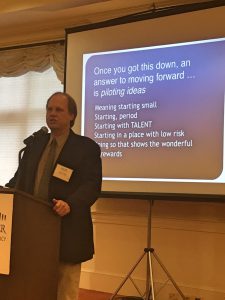Last week, I attended the Advancing Student-Centered Learning Forum in Devens, MA. This forum was hosted by the Rennie Center for Education Research & Policy. It provided a platform for school and education leaders to discuss the landscape of education in Massachusetts, and how educators with supportive policy can help students excel through personalized, student-centered approaches.
As a newly minted member of the Students at the Center Hub team at Jobs for the Future, there was a lot to wrap my head around. Throughout the day-long forum, however, there were a few key conversations and sessions that had me thinking more deeply, not just about student-centered learning and how to advance it in my own work, but also about education in general. I gleaned that progress toward more student-centered approaches at scale will involve lots of innovation and will be a little bit messy, but there is a willingness and appetite to continue the good, deep work that is happening in schools and districts across Massachusetts.
Here are a few of my takeaways:
Student voice is imperative in any conversation about student-centered learning.
We had a chance to hear from three students about how student-centered learning practices and approaches changed their educational outcomes. Nothing moved me more than hearing a former student of Alternative Choices in Education, a competency-based program at Brookline High School, say, “I felt empowered because I chose to be in [the Alternative Choices in Education program] and I was empowered because my choice made me successful. Now, I want to be a teacher; I want to make sure that students know that I care about them.” Students can truly be empowered through education and through their teachers to find their voices and be agents of equity and empathy in education today and in the future. Hearing firsthand about the impact of student-centered learning in these students’ lives was a highlight for me.
Our educational system needs to be malleable to prepare students for the future.

 Start small.
Start small.
Educators and school leaders shared their perceived barriers to implementing student-centered learning: “I’d never get my teachers on board”; “What will this cost per student? We have a small budget”; “My district would never support me.” Chris Unger, EdD, associate teaching professor at the Graduate School of Education at Northeastern University, provided a two-word solution to these seemingly insurmountable hurdles: “Start small.” Start with a small program, start with a classroom, start with one lesson on your curriculum. Big changes don’t have to start in the biggest way possible.
Can we start small when student-centered learning strategies are not universally defined?
This was a huge “a-ha” moment for me. During one of the final sessions, it was clear that there were some misunderstandings about a few different terms. For example, many of the terms we have grown to see as synonymous, like project-based learning and competency-based learning, aren’t exactly synonymous. There was a debate about the key differences in these two terms when the participants were asked, “what does competency-based learning look like to you?” Some in the group suggested project-based ideas. However, there were a few educators who felt competency-based learning can be project-based, but not all project-based learning is competency-based. They pushed for a broader definition and understanding. It got me thinking about the work I do for the Hub, how I have more work to do in grasping student-centered learning, and how to think through giving more clarity to the four principles of student-centered learning. Thankfully, the Students at the Center team has already done some of the hard work of demystifying and clarifying these terms, and I’ll be spending a lot more time with them.
Thanks to the Rennie Center, and organizations like it, these conversations are happening and impacting classrooms, schools, and policy in Massachusetts and across New England.
Is your school taking student-centered learning approaches? Share them with us. Do you have any questions about student-centered learning? Are there any specific questions about the framework that we can give clarity on? We’d love to hear from you.
 Start small.
Start small.